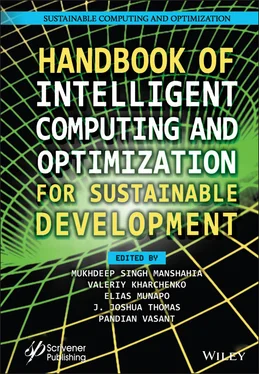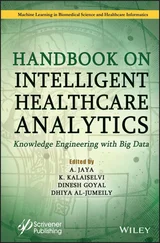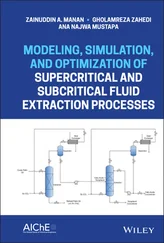Handbook of Intelligent Computing and Optimization for Sustainable Development
Здесь есть возможность читать онлайн «Handbook of Intelligent Computing and Optimization for Sustainable Development» — ознакомительный отрывок электронной книги совершенно бесплатно, а после прочтения отрывка купить полную версию. В некоторых случаях можно слушать аудио, скачать через торрент в формате fb2 и присутствует краткое содержание. Жанр: unrecognised, на английском языке. Описание произведения, (предисловие) а так же отзывы посетителей доступны на портале библиотеки ЛибКат.
- Название:Handbook of Intelligent Computing and Optimization for Sustainable Development
- Автор:
- Жанр:
- Год:неизвестен
- ISBN:нет данных
- Рейтинг книги:5 / 5. Голосов: 1
-
Избранное:Добавить в избранное
- Отзывы:
-
Ваша оценка:
- 100
- 1
- 2
- 3
- 4
- 5
Handbook of Intelligent Computing and Optimization for Sustainable Development: краткое содержание, описание и аннотация
Предлагаем к чтению аннотацию, описание, краткое содержание или предисловие (зависит от того, что написал сам автор книги «Handbook of Intelligent Computing and Optimization for Sustainable Development»). Если вы не нашли необходимую информацию о книге — напишите в комментариях, мы постараемся отыскать её.
This book provides a comprehensive overview of the latest breakthroughs and recent progress in sustainable intelligent computing technologies, applications, and optimization techniques across various industries.
Audience Handbook of Intelligent Computing and Optimization for Sustainable Development
Handbook of Intelligent Computing and Optimization for Sustainable Development — читать онлайн ознакомительный отрывок
Ниже представлен текст книги, разбитый по страницам. Система сохранения места последней прочитанной страницы, позволяет с удобством читать онлайн бесплатно книгу «Handbook of Intelligent Computing and Optimization for Sustainable Development», без необходимости каждый раз заново искать на чём Вы остановились. Поставьте закладку, и сможете в любой момент перейти на страницу, на которой закончили чтение.
Интервал:
Закладка:

Figure 5.1 ML application for communications (re-generated from [24]).
5.2.1 Automatic Modulation Classification
AMC is the process of classifying the modulation scheme of a signal and is a core technique of non-cooperative communication. It is an intermediary step between signal reception and signal demodulation. It is essential for rapid response and signal identification in dense electromagnetic spectrums in the presence of channel noises and multipath effects in military, cognitive radio, and 5G network applications. The two key steps in the design of a modulation classifier are signal pre-processing and selection of an effective classification algorithm. The pre-processing section might include (but are not limited to) reduction of signal noise, estimation of carrier frequency and signal power and extraction of essential signal information (as per the requirements of the classification algorithm) [27]. As for the second part, modulation classification algorithms can be either likelihood based, or feature based. Likelihood-based classifiers essentially work by comparing the likelihood ratio of the received signal against a predetermined threshold and have the advantage of minimizing the probability of a false classification but are more complex, require higher computational power, and are more difficult to implement in hardware. Feature-based classification has two main subsystems 1: feature extraction (which can be considered a pre-processing step) [28] and 2: classification [29, 30]. This method makes use of certain specific features of the received signal and classifies based on these feature values. Although they have less than optimal performance, feature-based classifiers greatly reduce computational complexity and can be acceptable with proper design.
A wide amount of work has been done in feature-based AMC and the application of DL algorithms directly on the received signal, thereby eliminating the feature extraction step and further reducing computational complexity. The application of CNN in AMC has shown promising accuracy which can ensure acceptable performance with much lower cost of computation. The next step would be to find effective hardware implementation of DL-based AMC classifiers [31].
5.2.2 Resource Allocation (RA)
The RA problem in wireless communication systems is considered as one of the most challenging tasks. The RA problem is formulated as an optimization problem and usually solved online with available information [32]. It is difficult to obtain a real-time optimal solution for most RA problems due to their nonconvex nature. To solve these problems, Lagrangian and greedy methods are employed which results in performance degradation [33]. The nonlinear programming (NLP) methods were used to solve the RA problem, due to their cubic complexity, the implementation of these methods were also targeted on graphics processing units (GPUs) for faster processing [34]. Hence, the traditional algorithms for RA are facing great challenges in achieving the QoS requirement of the users in scarce wireless scenarios. RA has a great ability to provide a guaranteed user’s QoS by optimizing the available facilities to minimize operational cost and maximize the operator’s revenue. Therefore, the efficient RA is always a trending topic for future wireless communication networks.
In recent years, there has been a drastic increase in internet traffic and expected to grow in future wireless systems [2, 35]. This traffic growth contributed by the various applications such as wide variety of user equipment (UE), smartphones, automatic vehicles, and IoT sensors. Due to this enormous growth in internet traffic, radio RA in future wireless networks (5G and beyond) is becoming more challenging. Therefore, RA resurfaced as a trending topic in the wireless communication area [36]. DL methods have a great potential to efficiently optimize the radio resource in future wireless systems. Recently, Zhou et al . [37] proposed a DL-based radio RA in ultra-dense 5G networks. In [37], authors have proposed LSTM method for RA problem in 5G scenario and achieved low packet loss along with high throughput. Wang et al . [38] and Zhang et al . [39] presented ML-based RA problems assisted with cloud computing. DL has shown great potential and provided a break-through in a variety of research areas [21].
5.2.3 Channel Estimation/Signal Detection
The application of a neural network (NN) for channel estimation is influenced by the channels which are challenging to describe. This problem may ensue from a provision that inhibit the possession of CSI at the receiver (CSIR) or an unavailability of a well-known channel models. For instance, in MIMO systems with low-resolution analog-to-digital converters (ADCs), consistent CSIR cannot be achieved due to the abrasive quantization instituted by the ADC [22]. In molecular communication systems, the fundamental channel models are indefinite [40]. Therefore, both systems offer themselves to NN-based detectors. Jeon et al . [40] draw a contrast in speech recognition and found that this a domain in which DL algorithms have done extremely good. Speech recognition and digital communication both begin with a signal which is generally sent over a channel to some receiver. This channel can be a wireless, acoustic, or chemical and a receiver can be a microphone, cell phone, or chemical sensor. The receiver tends to detect the original transmitted signal. This evaluation emphasizes the ability of DL algorithms in signal detection over undetermined channels.
In wireless detection, we initially estimate the parameters of a channel over which the signal is being transmitted. These estimates of the CSI are needed for detection at the receiver. Conventional algorithms to estimate CSI, such as minimum mean square error (MMSE) or maximum a posteriori probability (MAP) estimation, necessitate an analytical model of the channel, but the blend of channel distortion and hardware imperfections can be challenging to model systematically. Authors in [41] employed a DL-based method to estimate the carrier frequency offset (CFO) and timing estimates to empower detection of single carrier phase-shift keyed signals.
5.2.4 Millimeter Wave
The mmWave communication serves as a promising solution to improve the spectral efficiency and the problem of shortage of frequency resource [42]. Many applications are related to mmWave communication such as beamforming, precoding, and channel estimation. Power allocation are used for mmWave with non-orthogonal multiple access (NOMA)–related applications. The blockages when mmWaves are being used are generally high because of their short range. Those blockages tend to disrupt the signal strengths and signal quality. A multi-layer perceptron (MLP) DL model is used to predict these blockages caused [43]. The mmWave channel has a sparse nature by which instead of beam searching completely, the alignment of beam can be done which reduces the need of more channel measurements [44]. When it comes to massive MIMO, many more antennas are involved. So, the problem of channel detection or channel estimation becomes more critical as the traditional methods are utilized. Channel estimation for mmWave communication is challenging because of the huge training overhead and strict constraints on RF chain usage because of the requirement of large number of transmitter and receiver antennas [45]. A MLP-based channel equalization technique has been proposed in [46]. The CSI is generally obtained by the user in the downlink and its feedback to the transmitter in uplink. Even though the process seems to be simple the problem arises as more antennas are involved in massive MIMO systems. The increased overhead during feedback causes the time lag when being processed at transmitter side. A CNN-based feedback for CSI is developed in [20] to address this issue. MLPs are basic feed forward NNs used for classification and detection tasks. A CNN, on the other hand, was developed for classification of images but now used in wireless communication as well. Before the use of complex convolutions, most of the problems related to DL and ML have used real operations. These convolutions have proved to give increased performance even in the presence of noise and are easy to represent. The imaginary phase component present here is very important in signal processing. It is sufficient to recover information pertaining to the magnitude part. It also provides description about the shape, orientation of the objects. Parallel complex convolution blocks and its counterparts are defined and explained in [47].
Читать дальшеИнтервал:
Закладка:
Похожие книги на «Handbook of Intelligent Computing and Optimization for Sustainable Development»
Представляем Вашему вниманию похожие книги на «Handbook of Intelligent Computing and Optimization for Sustainable Development» списком для выбора. Мы отобрали схожую по названию и смыслу литературу в надежде предоставить читателям больше вариантов отыскать новые, интересные, ещё непрочитанные произведения.
Обсуждение, отзывы о книге «Handbook of Intelligent Computing and Optimization for Sustainable Development» и просто собственные мнения читателей. Оставьте ваши комментарии, напишите, что Вы думаете о произведении, его смысле или главных героях. Укажите что конкретно понравилось, а что нет, и почему Вы так считаете.












